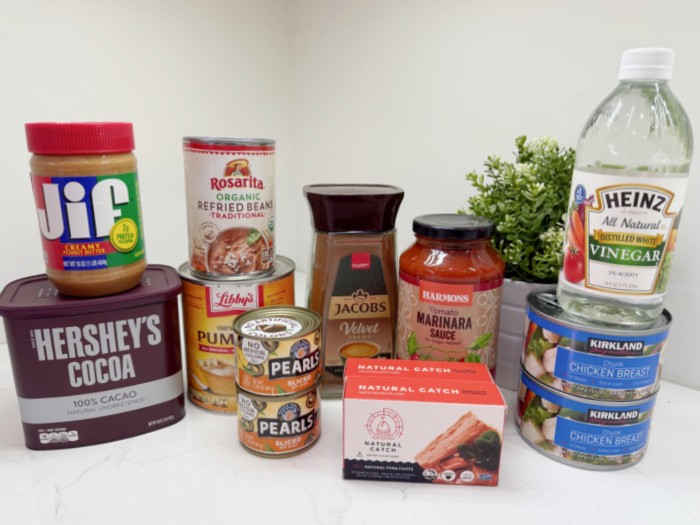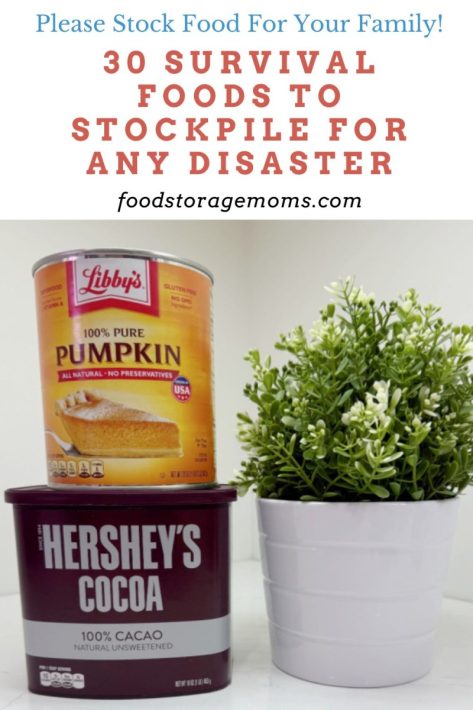
For many disasters or unforeseen emergencies, we suggest stockpiling the things needed for that specific disaster. However, sometimes, we don’t know what could happen. Because you never know, we have compiled a list of 30 survival foods that you can stockpile no matter what happens.
Things to Keep in Mind
As you stockpile, you should keep a few things in mind. Consider the following things when you are putting together your survival foods:
- Make sure you have at least a 3-day supply of non-perishable food. I recommend much longer (at least a month), but 3 days is a good starting point.
- Get foods that you know your family will eat.
- Don’t forget to accommodate special dietary needs, such as formula or baby food.
- Avoid foods that will make you thirsty or dehydrate you, especially if you have a limited water supply.
- Check out my post: “How to Store your Food Storage” to ensure you properly store your survival foods.
- Don’t forget to stockpile water as well!
- Related: How to Store Water for Drinking and Cooking
30 Survival Foods to Stockpile

Survival food is food that you need to survive any emergency or disaster. Here are the foods suggested by Ready.gov:
- Wheat Berries: Get these in #10 cans since they store well while retaining nutrition. Your wheat berries can be turned into flour, cooked whole as a hot cereal, or added to soups and stews.
- Salt: Salt doesn’t just season things. We used to use salt to preserve food. It is still a great way to preserve food, and we also need it in our diet.
- Ready-to-eat canned food: These are essential, especially if something happens where you can’t cook your food. Get canned meats, fruits, and vegetables.
- Protein bars: If your meat goes bad because you lack power, this is a great way to get the protein you need.
- Dry cereal or granola: These last quite a while and are good to eat, whether you can cook or not.
- Peanut butter is an excellent protein food that lasts at least 12 months. You can eat it even without bread.
- Dried fruit: Fruit is good for your body, and dried fruit lasts much longer than fresh fruit. These provide potassium and other nutrients as well.
- Canned juices: Fruits contain natural sugars, and fruit juices can keep your sugar levels up if you don’t have enough food. Additionally, they are suitable for restoring electrolytes.
- Non-perishable milk: Canned or instant milk is an excellent source of vitamin D. You won’t have to worry if the power goes out.
- Food for babies and infants: If you have a baby or infant, stock up on formula, baby food, and snacks for the child.
More Survival Foods to Stockpile
Here are some additional foods we recommend you stockpile:
- Canned soups and chili: These can be eaten straight out of the can and offer a variety of nutrients.
- Dry pasta: Carbs help keep you full and give you energy. Stock them since they are easy to fix and offer many meal options.
- Sports drinks: Gatorade and Powerade can help replenish electrolytes if water is scarce. Consider getting them with less sugar.
- Honey: Honey is a natural preservative, immune booster, antibacterial, and antifungal. It will help keep you healthy.
- Baking soda is cheap, a great leavening agent, and can be combined with vinegar to make bread and cakes in place of eggs. It’s also good for cleaning and deodorizing.
- Dry yeast is essential for making many types of bread. You can also learn to make your own yeast starters.
- Popcorn: Plain popcorn kernels are easy to store and last a long time. Once popped, they make great snacks and can even be popped over a fire.
- Instant Potatoes last about a year and require very little cooking energy. Just add some boiling water, and you have something filling your belly.
- Crackers: Crackers are a great carb source. They make soups more filling and help you make it to the next meal.
- Beans: These are long-term survival items. They are full of protein and very filling. Additionally, they are inexpensive and easy to store and come in various types for variety in meal planning.
- Rice: Rice is similar to beans. It’s easy to store, filling, and lasts a long time.
- Lentils: Lentils cook faster than beans, which require less energy but offer the same amount of protein.
- Oatmeal: Oatmeal can be stored without refrigeration. It makes a great breakfast or can be added to meats.
- Nuts: Nuts such as peanuts, almonds, pecans, and other varieties can be easily stored and packed with protein.
- Pasta sauce: This sauce is a great addition to pasta and is a great way to make a quick and easy meal.
- Tea: Tea is a natural antibacterial and is suitable for medicinal purposes.
- Oils: It’s hard to cook anything without oil or fat. Stockpile vegetable oil, butter, coconut oil, olive oil, lard, or your preferred choice.
- Corn starch: This is great for baking and thickening.
- Pancake mix: Get one of the varieties that only needs water to make the batter.
- Eggs and powdered eggs: Eggs are a good source of protein, and they are used in many recipes. Powdered eggs may last longer; please check your brand before purchasing.
- Chocolate: I must add chocolate. It can be cocoa, chocolate chips, or dark chocolate. M&M’s are really good!
Alternative Cooking Methods
Did you know that even if you can’t use your stove or grill, you can use alternative cooking methods? Here are just a few ways you can cook without your stove:
- Dutch Ovens with charcoal (outside)
- Butane Stoves and Butane Fuel
- Camp Chef Stove/Oven (uses propane)
- BBQ Grills
What to Do With Survival Foods with No Power Available
You must stockpile foods that don’t need to be refrigerated. Also, plan to have some refrigerated and frozen foods as part of your food stockpile, since the power MAY not go out. Here is what you can do if you lose power:
- Keep your refrigerator and freezer closed as much as possible. Unopened, the food will stay cold for 4 hours or longer.
- Check the temperature in the fridge or freezer using a thermometer. It needs to be at 0°F (-18°C).
- You must dispose of them if they have been above 40 degrees Fahrenheit for more than 2 hours. When in doubt, throw it out.
- If you live in an area with temperatures below 0°F (-18°C), you could put the food outside to prevent spoiling.
Can I Use Dry Ice?
The key to dry ice is to have it or know where to get it before a power outage. Here’s what you need to know about dry ice:
- Twenty-five pounds of dry ice will keep a 10 cubic foot freezer below freezing for 3 to 4 days!
- If you use dry ice to keep your food cold, do not let it directly contact the food.
- Be careful when using dry ice. Wear dry, heavy gloves so you don’t experience personal injury.
Final Word
Regarding survival foods, think of foods you can eat without electricity, power, or a heating source. Try to get commercial #10 cans produced and packed by professionals. Remember, luck favors the prepared. Get to the store NOW to grab these survival foods to stockpile. Please don’t wait until it’s too late! May God bless this world, Linda
Copyright Images: Emergency Food on Counter Deposit photos_377044208_s-2019
The post 30 Survival Foods to Stockpile for Any Disaster appeared first on Food Storage Moms.
from Food Storage Moms
No comments:
Post a Comment